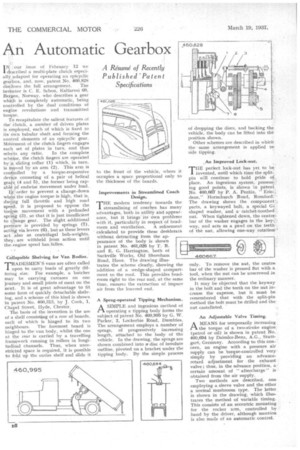An Automatic Gearbox
Page 116

If you've noticed an error in this article please click here to report it so we can fix it.
A Resume of Recently PublishedPatent Specifications
I N our issue of February 12 we 4scribed a multi-plate clutch especially:adapted for operating an epicyclic gearhox, and, now, patent No. 460,828
discloses the full arrangement. The invntor is C. E. Schou, Kalfarvei 69, Bei-gen, Norway, who describes a gear which is completely automatic, being controlled by the dual conditions of engine revolutions and transmitted torque.
To recapitulate the salient features of the' clutch, a number of driven plates is employed, each of which is fixed to its Own tubular shaft and forming the control elements of an epicyclic gear. MOVement of the clutch fingers engages each set of plates in turn, and thus selects any ratio. In the complete seheine, the clutch fingers are operated by g sliding collar (1) which, in turn, is ineved by an arm (2). This arm is contAolled by a torque-responsive tle*e consisting of a pair of helical ge.ats (4 and 5), the former being capabl4 Of endwise movement under load.
order to prevent a change-down when the engine torque is high, that is, durilig full throttle and high road speed, it is proposed to oppose the torktie movement with a preloaded spritAg (3), so that it is just insufficient to Ounge gear. The slight additional pressure is provided by springs (7), acti-4 via levers (6), but as these levers act : also as centrifugal bob-weights, they are withheld from action until the, engine speed has fallen.
Ceillapsible Shelving for Van Bodies.
er'RADESMEN'S vans are often called 1. upon to carry loads of greatly differing size. For example, a butcher may be carrying carcases on one journey and small joints of meat on the next.. It is of great advantage to fit some form of quickly detachable shelving, and a scheme of this kind is shown in patent No. 460,313, by 3. Cook, 1, Chapel Street, Hyde, Chester.
The basis of the invention is the use of a shelf consisting of a row of boards, each of which is hinged to its two neighbours. The foremost hoard is hinged to the van body, whilst the one at the rear is carried by a travelling franiework running in rollers in longitudinal channels. Thus, when unrestricted space is required, it is possible to fold up the entire shelf and slide it to the front of the vehicle, where it occupies a space proportional only to the thickness of the boards.
Improvements in Streamlined Coach Design.
THE modern tendency towards the . streamlining of coaches has many advantages, both in utility and appearance, but it brings its Own problems with it, particularly in respect of head
room and ventilation. A refinement calculated to provide these desiderata without detracting from the ap pearance of the body is shown in patent No. 461,026 by T. R. and E. G. Harrington, both of Sackville Works, Old Shoreham Road, Hove. The drawing illustrates the scheme clearly, showing the addition of a wedge-shaped compartment to the roof. This provides headroom right to the rear and, at the same time, ensures the extraction of impure air from the louvred end.
A Sprag-operated Tipping mechanism.
ASIMPLE and ingenious method of operating a tipping body forms the subject of patent No. 460,995 by G. W. Parker, 2, Lockerbie Road, Dumfries The arrangement employs a number of spra.gs, of progressively increasing length, attached to the body of the vehicle. In the drawing, the sprags are shown combined into a disc of involute outline, pivoted on a bracket under the tipping body. By the simple process
of dropping the discs, and backing the vehicle, the body can be lifted into th position shown.
Other schemes are described in which the same arrangement is applied to' side tipping.
An Improved Lock-nut.
THE perfect lock-nut has yet to be invented, until which time the split;. pin will continue to hold pride of, place. An ingenious system, possessing good points, is shown in patent No. 460,667 by P. A. Pentin, "Ericdene," Hornchurch Road, Romford::The drawing shows the component', parts, a keywayed bolt, a special shaped washer, and aratchet-toothed,: nut. When tightened down, the centre: bar of the washer engages in the keyj.,! way, and acts as a pawl on the teeth of the nut, allowing one-way rotation
only. To remove the nut, the centrebar of the washer is pressed flat with a tool, when the nut can be unscrewed in the ordinary manner.
It may be objected that the keyway in the bolt and the teeth on the nut increase the expense, but it must be remembered that with the split-pin method the bolt must be drilled and the nut castellated.
An Adjustable Valve Tuning.
AMEANS for temporarily increasing the torque of a two-stroke engine (petrol or oil) is shown in patent No.. 460,694 by Daimler-Benz, A.G., Stuttgart, Germany. According to this concern, an engine with a pressure air supply can be torque-controlled very simply by providing an advanceretard adjustment for the exhaust valve ; thus, in the advance position, a• certain amount of " aftercharge " is obtained from the air supply.
Two methods are described, one employing a sleeve valve and the other a normal mushroom type. The latter is shown in the drawing, which illustrates the method of variable timing. This consists of an eccentric mounting for the rocker arm, controlled by hand by the driver, although mention is also made of an automatic control.
























































































































































